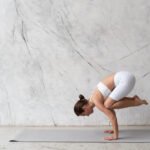Welcome to your next step in the exhilarating journey of yoga. Today, we’re diving into the Eka Pada Galavasana, commonly known as the Flying Crow Pose. This dynamic and engaging posture is more than just a physical feat; it’s a fusion of strength, balance, and mental focus.
Eka Pada Galavasana stands out in yoga practice for its ability to challenge and enhance your arm and core strength, balance, and hip flexibility. It’s not just a pose; it’s a journey through physical and mental boundaries, pushing you to explore the limits of what you thought possible.
The beauty of the Flying Crow Pose lies in its complexity. It harmonizes strength with grace, testing your physical capabilities while nurturing an inner sense of focus and calm. As you engage in this pose, you’re not just working your muscles; you’re opening a dialogue between your body and mind, fostering a deeper understanding of your physical and mental self.
Whether you’re a seasoned yogi or a curious beginner, the Flying Crow Pose has something to offer. Its benefits extend beyond the yoga mat, providing a metaphor for balance and resilience in everyday life. As you learn and grow with this pose, you’ll find it’s not just about the physical execution but the journey of self-discovery and empowerment it represents.
Join us as we embark on this detailed exploration of Eka Pada Galavasana. We’ll guide you through every step, ensuring you have the tools, knowledge, and confidence to integrate this remarkable pose into your yoga practice.
Prerequisites for Flying Crow Pose
Before you embark on the journey of mastering the Flying Crow Pose (Eka Pada Galavasana), it’s important to establish a solid foundation. This pose is not just about strength; it requires a synergy of flexibility, balance, and core engagement. Let’s explore the prerequisites needed to prepare your body and mind for this challenging yet rewarding asana.
Yoga Proficiency Level Required
The Flying Crow Pose is considered an advanced yoga posture. It’s essential to have a good grasp of basic yoga principles and a certain level of physical fitness. If you’re new to yoga, it’s advisable to spend time familiarizing yourself with fundamental poses and building up your practice before attempting Eka Pada Galavasana.
Preparatory Poses and Exercises
Arm Strength Building
Strong arms are crucial for supporting your body weight in the Flying Crow Pose. Focus on poses that enhance upper body strength, such as:
- Chaturanga Dandasana (Four-Limbed Staff Pose)
- Adho Mukha Svanasana (Downward-Facing Dog)
- Bakasana (Crow Pose)
These poses will help build the necessary arm strength and teach you how to engage your shoulders and arms effectively.
Core Strengthening
A robust core is the key to maintaining balance and stability in the Flying Crow Pose. Incorporate core-focused exercises and poses into your routine, such as:
- Plank Pose
- Navasana (Boat Pose)
- Utkatasana (Chair Pose)
These will enhance your core stability, making it easier to maintain balance during the pose.
Hip Opening Exercises
Flexibility in the hips is essential for comfortably getting into the pose. Engage in hip-opening exercises and poses like:
- Malasana (Garland Pose)
- Pigeon Pose
- Baddha Konasana (Bound Angle Pose)
These poses will increase your hip flexibility, allowing for a smoother transition into the Flying Crow Pose.
Tips for Building Up to Flying Crow Pose
- Consistency is Key: Regular practice of these preparatory poses will gradually build the strength and flexibility needed.
- Listen to Your Body: Pay attention to your body’s signals. If a pose feels too challenging, don’t force it. Gradual progression is more beneficial and safer.
- Mind-Muscle Connection: Focus on engaging the correct muscles during each pose. Understanding how to activate these muscles will significantly help when attempting the Flying Crow Pose.
Preparing for Eka Pada Galavasana is a journey that requires patience, dedication, and mindful practice. By focusing on these prerequisites, you’re setting yourself up for a successful and rewarding experience with the Flying Crow Pose.
Step-by-Step Guide to Performing Flying Crow Pose
Mastering the Eka Pada Galavasana, or Flying Crow Pose, is a journey of balance, strength, and focus. This step-by-step guide is designed to help you safely and effectively perform this challenging asana. Remember, patience and consistent practice are key.


Starting Position
- Begin in a squatting position: Start by squatting down, keeping your feet a few inches apart. This low center of gravity will be your base.
- Place your hands on the mat: Position your hands firmly on the mat, shoulder-width apart, with fingers spread wide for stability.
Hand and Arm Positioning
- Bend your elbows slightly: Think of a Chaturanga arm position, where your elbows are bent and tucked close to your body.
- Lean forward: Shift your body weight forward, transferring more weight onto your hands. This requires confidence and a bit of a leap of faith.
Core and Leg Engagement
- Engage your core: Activate your abdominal muscles to help maintain balance.
- Lift one foot off the ground: Start with the foot you feel most comfortable with. Raise it off the ground by bending the knee and bringing it towards your torso.
- Position your knee: Carefully place your raised knee on the back of your upper arm, near the armpit. This creates a shelf for your leg.
Balance and Alignment Tips
- Keep your gaze forward: Focus on a point ahead of you. This helps in maintaining balance.
- Lift your other foot: Once you feel stable, slowly lift your other foot off the ground, bringing it close to your buttocks.
- Straighten the lifted leg: Extend the leg that is in the air out behind you. It requires both strength and balance to maintain this position.
- Align your body: Ensure your back is straight, and your hips are level. Avoid leaning too far forward or back.
Common Mistakes and Avoidance Tips
- Rushing into the pose: Take your time to find your balance. Rushing can lead to misalignment and potential injury.
- Not engaging the core: A strong core is essential for balance. Remember to engage your abdominal muscles throughout the pose.
- Ignoring hand placement: Your hands are your foundation here. Ensure they are firmly planted and fingers are spread for maximum stability.
Modifications and Props for Beginners
The Flying Crow Pose (Eka Pada Galavasana) can be quite challenging, especially for beginners. However, with the right modifications and the use of props, it becomes more accessible. These adjustments are designed to help you gradually build up strength and confidence in the pose.
Pose Modifications for Beginners
- One-Legged Variation: Instead of extending the lifted leg fully, keep it bent at the knee. This reduces the balance and strength required, making it easier to maintain the pose.
- Use a Wall for Support: Practicing near a wall can provide a sense of security. If you lose balance, the wall is there to catch you.
- Elevate Your Feet: Start with your feet on a raised surface, like a low bench or a block. This elevation makes it easier to lift into the pose.
Use of Props
- Yoga Blocks: Place a block under each hand to raise your upper body. This lessens the angle of your bend and makes it easier to lift into the pose.
- Yoga Straps: Use a strap around the arms just above the elbows to keep them from splaying outwards. This helps in maintaining a strong arm position.
Progression Tips to Full Pose
- Gradual Progression: Start with modifications and slowly reduce the level of assistance as you get stronger and more confident.
- Frequent Practice: Regular practice, even for short durations, can significantly improve your strength and balance over time.
- Focus on Core Strength: A strong core is crucial for this pose. Incorporate additional core exercises into your routine to build this strength.
- Patience and Perseverance: Progress takes time, and every small improvement is a step towards mastering the full pose. Celebrate these small victories along the way.
Advanced Variations of Flying Crow Pose
For those who have mastered the basic form of the Flying Crow Pose (Eka Pada Galavasana), exploring advanced variations can add an exciting new dimension to your practice. These variations increase the challenge, requiring more strength, flexibility, and balance, making them ideal for seasoned practitioners looking to deepen their yoga journey.
Challenges for Advanced Practitioners
- Holding the Pose Longer: Increasing the duration of time you hold the pose is a straightforward way to deepen its intensity.
- Moving into Other Poses: Transitioning from Flying Crow into another challenging pose, such as Chaturanga or another arm balance, adds complexity to your practice.
- Practicing on an Unstable Surface: Performing the pose on a cushioned or uneven surface, like a yoga balance pad, can greatly increase the difficulty, challenging your balance and stability.
Variations to Increase Difficulty
- Eka Pada Galavasana with Extended Leg: Extend the leg that is resting on the arm fully forward, increasing the demand on your balance and core strength.
- Asymmetrical Arm Position: Try lifting one hand off the ground briefly or changing the position of your arms, challenging your balance and strength even further.
- Adding Movement: Incorporate dynamic movements, like gently swinging the extended leg or shifting your body weight, to increase the challenge.
Tips for Advanced Variations
- Warm-Up Thoroughly: Ensure your body is adequately warmed up before attempting these advanced variations to prevent injury.
- Focus on Breath Control: Maintaining steady, controlled breathing is crucial, especially as the difficulty increases.
- Stay Mindful of Body Alignment: As you explore these variations, maintain awareness of your body’s alignment to ensure safe practice.
- Listen to Your Body: Be attentive to your body’s signals. If a variation feels too strenuous, honor your limits and practice within a comfortable range.
Integrating Flying Crow Pose into Your Yoga Practice
Incorporating the Flying Crow Pose (Eka Pada Galavasana) into your regular yoga practice can enhance your overall experience, bringing in elements of strength, balance, and concentration. Here’s how you can seamlessly integrate this asana into different styles of yoga and create a holistic practice.
Sequences Including Flying Crow Pose
- Arm Balance Sequence: Include Eka Pada Galavasana in a sequence focused on arm balances. Begin with simpler poses like Crow Pose (Bakasana) and gradually progress to more challenging ones, culminating with Flying Crow Pose.
- Core Strengthening Sequence: Use Flying Crow as part of a core-focused sequence. Pair it with poses like Plank Pose, Boat Pose (Navasana), and Warrior III (Virabhadrasana III) to build a strong, engaged core.
- Hip-Opening Sequence: Since Flying Crow requires hip flexibility, include it in a sequence with hip openers like Pigeon Pose and Bound Angle Pose (Baddha Konasana).
Incorporation into Different Yoga Styles
- Vinyasa Flow: Incorporate Flying Crow in a dynamic Vinyasa flow, transitioning smoothly from one pose to another. It can be used as a peak pose in a challenging flow.
- Hatha Yoga: In a Hatha practice, hold the pose for several breaths, focusing on stability and alignment. This slower approach allows for deeper concentration and muscle engagement.
- Ashtanga Yoga: As part of an Ashtanga sequence, Flying Crow can be integrated into the standing series or as part of the arm balance set.
Warming Up and Cooling Down Tips
- Warming Up: Before attempting Flying
Visited 2 times, 1 visit(s) today









